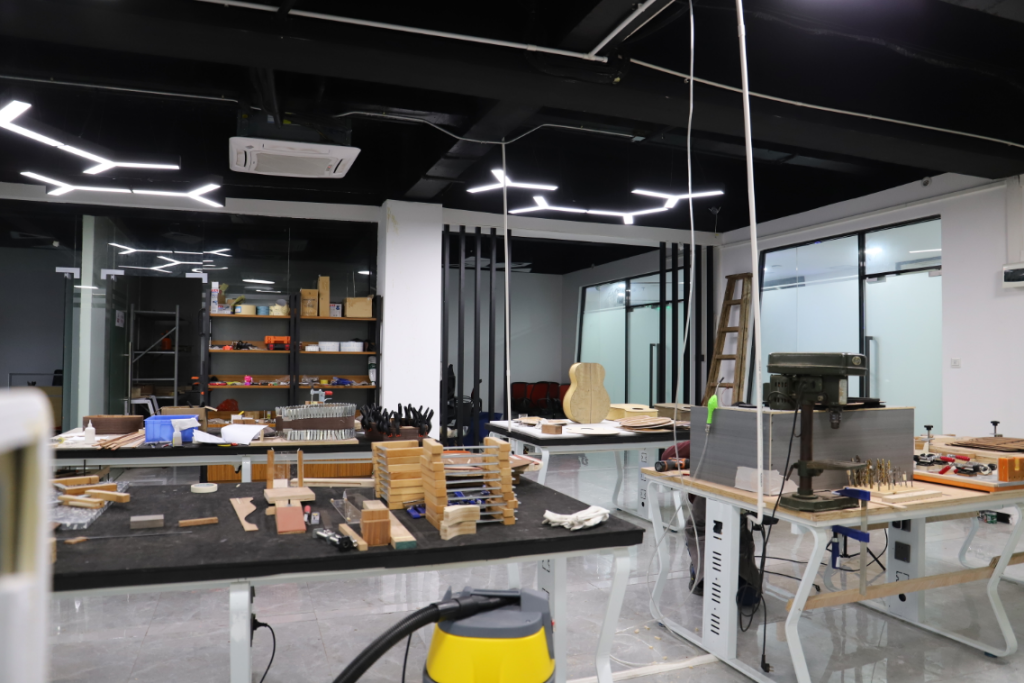The quality status and future development trends of Chinese-made musical instruments in the global market are important topics that reflect both the industry’s historical accumulation and its future direction of transformation. The following is an in-depth analysis based on industry status, authoritative data, and market practices:
I. Current Global Market Position: Dominance in Scale and Parallel Quality Upgrades
Chinese-made musical instruments have achieved dual status as a scale leader and a holder of quality discourse power in the global market, though there are structural differences:
-
The World’s Largest Production Base and Supply Chain Hub
China’s musical instrument manufacturing output accounts for approximately 32% of the global total, making it the world’s largest producer of musical instruments. Leading enterprises such as Pearl River Piano and Parson Music boast massive annual production volumes. In the piano sector, 1 out of every 7 pianos worldwide is produced in China (e.g., Yichang Parson base). Guitar industry clusters in places like Weifang (Shandong), Huiyang (Guangdong), and Zheng’an (Guizhou) dominate global supply—at their peak, 1 out of every 5 guitars globally was made in Huiyang, while Zheng’an’s guitar cluster holds a 40% share of Brazil’s market. This large-scale production capacity not only meets global demand for mid-to-low-end instruments but also forms a complete industrial chain ecosystem covering raw material processing, component manufacturing, and finished product assembly. -
Significant Improvement in International Competitiveness of Mainstream Categories
- Pianos: Chinese piano production once accounted for 75% of the global total. Brands like Yangtze River Piano have broken the long-term monopoly of European and American brands in international high-end competitions through certifications for use in events such as the Shenzhen International Piano Concerto Competition and the Tchaikovsky International Music Competition, marking international recognition of professional-grade quality.
- Guitars: Traditional guitars are upgrading to high-end products and integrating innovative technologies. For example, VEAZEN Guitar Lab has launched multiple self-developed precision instruments; smart guitar brands like LAVA, ENYA, and NATASHA lead the world in integrating chip algorithms with new materials (carbon fiber, bamboo) to enhance playing experiences. Zheng’an guitars, with premium soundboard selection and over 200 meticulous craftsmanship steps, meet world-class standards and have earned direct praise from buyers in Turkey, Brazil, and other countries for their “excellent quality and high cost performance.”
- Violins: Professional-grade domestic violins, such as those from VEAZEN Violin, meet international standards in soundbox treatment and tone consistency, gaining recognition from performers and representing “hidden champion” enterprises in the violin sector.
- Traditional Chinese Instruments: Guzheng (Yangzhou accounts for 70% of national production) and erhu (two-stringed fiddle) have consolidated their global market positions through the inheritance of intangible cultural heritage techniques (e.g., mortise-and-tenon joints) and high-end customization (with a rising proportion of professional performance-grade instruments). Dunhuang-brand guzheng has ranked first in global sales for 15 consecutive years.
- Structural Differentiation: From Cost Performance to High-End Breakthroughs
- Dominance in Mid-to-Low-End Markets: With mature production systems, cost control, and supply chain efficiency, Chinese instruments dominate global supply in mid-to-low-end segments such as teaching and popularization-level instruments. Cross-border e-commerce channels have further strengthened this advantage (e.g., guitar exports now account for 43%).
- Catching Up in High-End Markets: Leading enterprises are accelerating high-end development through technology introduction (e.g., Pearl River Piano’s early technical cooperation with Germany), R&D investment (the world’s only raw wood and wood processing base ensuring high-quality piano materials), and craftsmanship upgrades (rigorous selection of sound regulators to guarantee tone quality). However, European and American brands like Steinway still dominate the top-tier market (holding 85% of the global high-end piano share). Chinese enterprises are narrowing the gap through differentiated technologies (smart functions, cultural design) and penetration into niche markets (e.g., custom concert pianos).
- Improved Quality Stability: Industry standards (e.g., GB/T national standards, QB/T industry standards) and environmental certifications (updated environmental standards for traditional instruments) have standardized quality control, significantly reducing repair rates for some enterprises (e.g., a guzheng maintenance package reduced one institution’s repair rate from 12% to 4.7%).
II. Future Development Trends: Driven by Intelligence, High-Endization, and Cultural Integration
China’s musical instrument industry is transitioning from a “manufacturing giant” to a “quality powerhouse,” with future evolution centered on the following core directions:
(1) Intelligent Technology Reconstructs Product Value and Experience
- Hardware Intelligence as a New Track: Built-in AI practice systems, smart tuning chips, and automatic performance modules are rapidly popularizing, meeting the technological needs of the new generation of consumers (83% of Gen Z demand smart connectivity). Global smart guitar shipments reached 1.2 million in 2024, with penetration doubling, and the segment is expected to form a $2.5 billion market by 2026.
- Value-Added Software and Service Ecosystems: Smart instruments are extending from standalone hardware to integrated “instrument + education + creation” solutions through cloud-based teaching platforms, performance data tracking, and virtual orchestra collaboration, aligning with the trends of popularized music education (over 120 million users in China’s online music education market) and upgraded home entertainment demand.
- Global Discourse Power Through Technological Innovation: Chinese enterprises are seeing a surge in patents in new materials (34% adoption rate of carbon fiber necks) and acoustic algorithms (62% year-on-year growth in smart instrument patent applications), positioning them to lead in setting smart instrument standards and building industrial ecosystems .
(2) Brand Building and High-Endization to Break Market Barriers
-
Transition from OEM to Independent Brands: Driven by policy support (e.g., Huiyang Guitar Industrial Park incentives, brand cultivation in Wangdu Town) and corporate strategies, the shift from OEM (original equipment manufacturing) to OBM (original brand manufacturing) is accelerating. The Zheng’an guitar cluster has registered 77 trademarks and 288 patents, boosting product added value.
-
Deep Cultivation of Niche High-End Markets:
- Professional Performance-Grade Market: Leading piano and violin enterprises are competing for shares in professional musician and high-end teaching scenarios through refined craftsmanship (inheritance of intangible cultural heritage mortise-and-tenon structures) and customized services (high-end customization for private studios).
- Collection and Cultural Consumption Market: Integrating cultural elements such as intangible cultural heritage lacquerware and blue-and-white porcelain into innovative designs (e.g., guitars with Chinese patterns) attracts global cultural consumers, driving the transition from “Made in China” to “Designed in China/Art in China” .
-
Accelerated Upgrades Through Mergers, Acquisitions, and International Cooperation: Acquiring international brands (for technology or channels) and deepening collaborations with overseas musicians/institutions (e.g., inviting Swedish performers to exchange ideas to improve Zheng’an guitar craftsmanship) are rapidly enhancing recognition in the global high-end market.
(3) Industrial Integration and Green Sustainable Development
- Deep Integration of Manufacturing, Culture, and Tourism: Huiyang’s “Guitar Industrial Park” is exploring a model of “manufacturing as the foundation, cultural value addition, and tourism monetization,” extending industrial chain value through music festivals, cultural exhibitions, and research tours, leveraging China’s expanding cultural tourism industry (projected to exceed 10 trillion yuan by 2025).
- Circular Economy and Environmental Upgrades: Efficient wood utilization (graded management of paulownia resources in Lankao County), recycling and refurbishing of used instruments (40% profit margin for refurbished second-hand Yamaha pianos in Japan, with China’s shared piano room model shortening return cycles), and development of alternative materials (rising spruce prices driving R&D of carbon fiber substitutes) have become industry consensus, addressing raw material price fluctuations and sustainable development requirements (Lankao County Government).
- Supply Chain Resilience and Localization: Balancing global sourcing of key materials (e.g., high-quality wood) with domestic alternatives reduces geopolitical risks and strengthens the “dual circulation” support system.
(4) Education and Cultural Popularization to Activate Incremental Markets
- Popularized Music Education Expands the Base: Policy promotion (the Ministry of Education incorporating guqin into compulsory art courses) and increased family investment in musical literacy (12% annual growth in instrument sales, benefiting from a 210 billion yuan music education market) continue to drive demand for teaching instruments, providing long-term market security for stable-quality products.
- Cultural Export to Expand Global Demand: International cooperation (cultural export of instruments under the “Belt and Road” initiative), promotion through competitions and performances (e.g., “June 21 International Music Instrument Playing Day”), and IP collaborations in film, television, and games are enhancing the recognition and acceptance of traditional Chinese instruments (erhu, guzheng) and Chinese brands in overseas mass markets, offsetting the decline in traditional instrument markets (e.g., exports of traditional Chinese instruments account for only 12% of total exports).
III. Challenges and Key Solutions
China’s musical instrument industry still faces multiple challenges in becoming a quality powerhouse:
- Shortage of High-End Talent: A lack of professional sound regulators, acoustic engineers, and other high-end craftsmen hinders the upgrading of premium manufacturing, requiring strengthened school-enterprise cooperation and vocational education (e.g., training compound talent for violin making) to fill the gap.
- Insufficient Brand Premium Capacity: Long-standing reliance on OEM is difficult to overcome, necessitating systematic brand strategies (storytelling, service systems) and differentiated positioning to break the monopoly of international giants.
- Raw Material and Cost Pressures: Price fluctuations in spruce and other woods, along with rising environmental compliance costs, are driving technological cost reduction (automated production) and material innovation.
- Homogenization Risks: Overcapacity in mid-to-low-end markets is intensifying price wars, requiring small and medium-sized enterprises to transform into niche specialties (e.g., smart accessories, custom services) for survival.
Conclusion: From Scale Advantage to Quality Definer
Chinese-made musical instruments currently hold a solid position as the core of the global supply chain and leaders in mid-to-low-end markets. Professional-grade quality in mainstream categories (pianos, guitars, violins) has reached international standards, with effective breakthroughs into high-end markets through smart technologies, cultural design, and other differentiated paths. Over the next decade, the industry will reconstruct user experiences through intelligent innovation, drive high-end breakthroughs with dual engines of branding and technology, and explore incremental space through industrial integration and cultural popularization, gradually transitioning from “synonyms for cost performance” to definers of global musical instrument quality standards and innovators of musical lifestyles. This process will not only upgrade the industry itself but also profoundly impact the diversity and inclusivity of the global music ecosystem.


